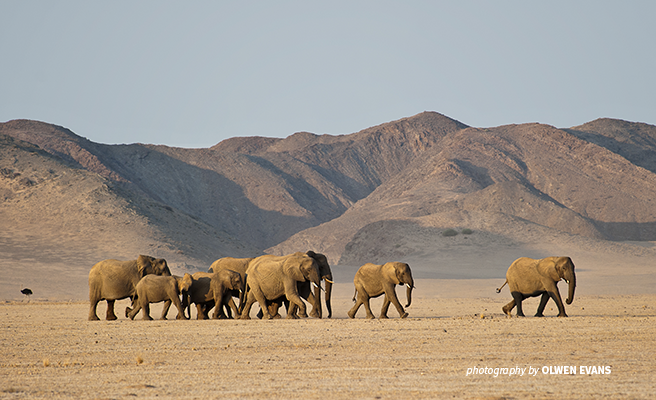Rare desert elephants survive Namibia’s harshest drylands

The world’s largest terrestrial mammal is also famed for being notoriously water-dependent. African savannah elephants in temperate rangelands drink water almost daily and love a mudbath to stay cool. Yet, in northern Mali’s Gourma region and the vast Namib Desert, this fascinating pachyderm survives despite the low rainfall and intense heat. These herds, aptly named desert elephants, traverse long distances in brutal arid environments with only seasonal rivers and scant vegetation for sustenance.
For years, ecologists thought desert-dwelling elephants were a separate species of Loxodonta africana, like the forest elephant found in the Congo River Basin’s dense tropical rainforests. But the distinctive characteristics and unique social structure of desert-dwelling elephants are simply adaptations to the extreme temperatures and the rocky plains of northwest Namibia’s Kunene region.
Desert elephants have big feet
There are no genetic or physiological differences between elephants found across Namibia’s wilderness — or the African savanna elephant’s continental rangeland — but the desert variety seems to look taller. Scientists attribute this long-legged illusion to its smaller body mass, the result of a lean diet of scattered grasses and shrubs. Desert-adapted elephants also appear to have bigger feet than those in more temperate landscapes because of their extended footpads. The greater surface area stops the elephant from sinking into the landscape’s iconic burnt orange sandy plains, crossing over dunes in search of food and water. Like their black rhino counterparts also found in the Kunene region, desert elephants walk for hundreds of kilometers at a time.
[[{"fid":"80643","view_mode":"full","fields":{"format":"full","alignment":"left","field_file_image_alt_text[und][0][value]":"Photo of lone desert elephant walking across rugged landscape in northwest Namibia","field_file_image_title_text[und][0][value]":"Desert-adapted elephants develop wider footpads to walk over the Namib's sandy terrain","field_caption[und][0][value]":"","field_caption[und][0][format]":"full_html"},"link_text":null,"type":"media","field_deltas":{"2":{"format":"full","alignment":"","field_file_image_alt_text[und][0][value]":"Photo of lone desert elephant walking across rugged landscape in northwest Namibia","field_file_image_title_text[und][0][value]":"Desert-adapted elephants develop wider footpads to walk over the Namib's sandy terrain","field_caption[und][0][value]":"","field_caption[und][0][format]":"full_html"}},"attributes":{"alt":"Photo of lone desert elephant walking across rugged landscape in northwest Namibia","title":"Desert-adapted elephants develop wider footpads to walk over the Namib's sandy terrain","height":400,"width":656,"class":"media-element file-full","data-delta":"2"}}]]
Desert-adapted elephants develop wider footpads to walk over the Namib's sandy terrain
[[{"fid":"80642","view_mode":"full","fields":{"format":"full","alignment":"right","field_file_image_alt_text[und][0][value]":"Photo of three adult desert-adapted elephants in northwest Namibia with rocky mountains in background ","field_file_image_title_text[und][0][value]":"Desert elephants must travel long distances to reach sources of water and food","field_caption[und][0][value]":"","field_caption[und][0][format]":"full_html"},"link_text":null,"type":"media","field_deltas":{"1":{"format":"full","alignment":"","field_file_image_alt_text[und][0][value]":"Photo of three adult desert-adapted elephants in northwest Namibia with rocky mountains in background ","field_file_image_title_text[und][0][value]":"Desert elephants must travel long distances to reach sources of water and food","field_caption[und][0][value]":"","field_caption[und][0][format]":"full_html"}},"attributes":{"alt":"Photo of three adult desert-adapted elephants in northwest Namibia with rocky mountains in background ","title":"Desert elephants must travel long distances to reach sources of water and food","height":400,"width":656,"class":"media-element file-full","data-delta":"1"}}]]
Desert elephants must travel long distances to reach sources of water and food
Adapting to water scarcity
Studies have shown that Namibia’s desert elephants have a remarkably straitened water intake. Female adult elephants and infants need water every three days; males can go up to five days without water. Researchers describe desert elephants as opportunistic drinkers and have also observed that they use their trunks and legs to dig wells in dry riverbeds — even when they have access to surface water or man-made drinking pools. Signaling their ancient memory of water sources, even if they are below the ground, this unique habit also tells of their need to purify water before they can drink.
[[{"fid":"80644","view_mode":"full","fields":{"format":"full","alignment":"","field_file_image_alt_text[und][0][value]":"Elephant herd travels through Damaraland Namibia","field_file_image_title_text[und][0][value]":"Desert elephants have been found to have smaller family units","field_caption[und][0][value]":"%3Cp%3EDesert%20elephants%20herd%20tend%20to%20travel%20in%20smaller%20herds%2C%20possibly%20because%20a%20smaller%20family%20unit%20is%20easier%20to%20feed%3C%2Fp%3E","field_caption[und][0][format]":"full_html"},"link_text":null,"type":"media","field_deltas":{"3":{"format":"full","alignment":"","field_file_image_alt_text[und][0][value]":"Elephant herd travels through Damaraland Namibia","field_file_image_title_text[und][0][value]":"Desert elephants have been found to have smaller family units","field_caption[und][0][value]":"%3Cp%3EDesert%20elephants%20herd%20tend%20to%20travel%20in%20smaller%20herds%2C%20possibly%20because%20a%20smaller%20family%20unit%20is%20easier%20to%20feed%3C%2Fp%3E","field_caption[und][0][format]":"full_html"}},"attributes":{"alt":"Elephant herd travels through Damaraland Namibia","title":"Desert elephants have been found to have smaller family units","height":400,"width":656,"class":"media-element file-full","data-delta":"3"}}]]
Desert elephants herd tend to travel in smaller herds, possibly because a smaller family unit is easier to feed
Smaller elephant herds travel further
Preferring to make their arduous journeys for food and water at night, desert elephants have also adjusted their feeding habits to make the most of the scarce resources. They will forage continuously for a few days before resuming the trek across the rugged Kunene region totaling over 115,000 sq. kilometers. Although elephant families are typically led by a matriarch and other female elephants, those dwelling in the harsh northwest exhibit a looser social structure. While scientists continue to investigate why they have noted that desert elephant family units are generally smaller than other continental populations. With fewer elephants per family, the herd is easier to feed — a much-needed survival tactic when food and water are days away in the harsh Namib Desert.
